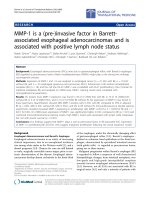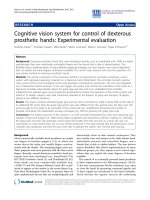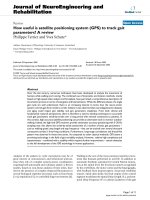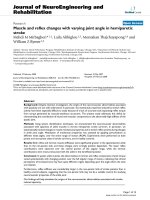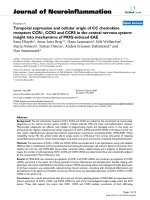báo cáo hóa học:" Bcl-2 expression is altered with ovarian tumor progression: an immunohistochemical evaluation" pptx
Bạn đang xem bản rút gọn của tài liệu. Xem và tải ngay bản đầy đủ của tài liệu tại đây (2.29 MB, 11 trang )
BioMed Central
Page 1 of 11
(page number not for citation purposes)
Journal of Ovarian Research
Open Access
Research
Bcl-2 expression is altered with ovarian tumor progression: an
immunohistochemical evaluation
Nicole S Anderson
1
, Leslie Turner
1
, Sandra Livingston
1
, Ren Chen
2
,
Santo V Nicosia
1,3
and Patricia A Kruk*
1,3
Address:
1
Department of Pathology and Cell Biology, University of South Florida, Tampa, FL 33612, USA,
2
Office of Clinical Research, University
of South Florida, Tampa, FL 33612, USA and
3
H. Lee Moffitt Cancer Center and Research Institute, Tampa, FL 33612, USA
Email: Nicole S Anderson - ; Leslie Turner - ; Sandra Livingston - ;
Ren Chen - ; Santo V Nicosia - ; Patricia A Kruk* -
* Corresponding author
Abstract
Background: Ovarian cancer is the most lethal gynecologic malignancy. The ovarian tumor
microenvironment is comprised of tumor cells, surrounding stroma, and circulating lymphocytes,
an important component of the immune response, in tumors. Previous reports have shown that
the anti-apoptotic protein Bcl-2 is overexpressed in many solid neoplasms, including ovarian
cancers, and contributes to neoplastic transformation and drug-resistant disease, resulting in poor
clinical outcome. Likewise, studies indicate improved clinical outcome with increased presence of
lymphocytes. Therefore, we sought to examine Bcl-2 expression in normal, benign, and cancerous
ovarian tissues to determine the potential relationship between epithelial and stromal Bcl-2
expression in conjunction with the presence of lymphocytes for epithelial ovarian tumor
progression.
Methods: Ovarian tissue sections were classified as normal (n = 2), benign (n = 17) or cancerous
(n = 28) and immunohistochemically stained for Bcl-2. Bcl-2 expression was assessed according to
cellular localization, extent, and intensity of staining. The number of lymphocyte nests as well as the
number of lymphocytes within these nests was counted.
Results: While Bcl-2 staining remained cytoplasmic, both percent and intensity of epithelial and
stromal Bcl-2 staining decreased with tumor progression. Further, the number of lymphocyte nests
dramatically increased with tumor progression.
Conclusion: The data suggest alterations in Bcl-2 expression and lymphocyte infiltration correlate
with epithelial ovarian cancer progression. Consequently, Bcl-2 expression and lymphocyte status
may be important for prognostic outcome or useful targets for therapeutic intervention.
Background
Ovarian cancer (OC) currently ranks 5
th
in cancer related
deaths among women in the United States [1] in spite of
advances in treatment. Despite an overall OC survival rate
of 45%, the five year survival rate for women diagnosed
with OC in its early stages is 94%, however these women
only make up 19% of reported OC cases [2]. This poor
prognosis is, in part, due to a lack of symptoms at early
Published: 25 October 2009
Journal of Ovarian Research 2009, 2:16 doi:10.1186/1757-2215-2-16
Received: 19 June 2009
Accepted: 25 October 2009
This article is available from: />© 2009 Anderson et al; licensee BioMed Central Ltd.
This is an Open Access article distributed under the terms of the Creative Commons Attribution License ( />),
which permits unrestricted use, distribution, and reproduction in any medium, provided the original work is properly cited.
Journal of Ovarian Research 2009, 2:16 />Page 2 of 11
(page number not for citation purposes)
stages as well as lack of a screening marker available to the
general public. The ovarian surface epithelium is generally
believed to be the origin for the majority of epithelial
ovarian cancer cases [3], though current reports of a fallo-
pian tube origin for ovarian cancer have emerged [4,5].
Consequently, the etiology of ovarian cancer is still poorly
understood.
A basement membrane consisting mainly of collagenous
connective tissue separates the ovarian surface epithelium
(OSE), a modified mesothelium, from underlying ovarian
stromal tissue [6]. The OSE and stroma both synthesize
and secrete components that contribute to deposition of
the basement membrane during postovulatory repair [7].
Normal ovarian stroma also produces an array of growth
factors, including, but not limited to transforming growth
factor-
1
(TGF-
1
) and the hepatocyte growth factor
(HGF) receptor c-Met that stimulate autocrine and para-
crine-mediated proliferation of the superjacent epithe-
lium. These growth factors tend to be overexpressed in
many carcinomas, hence facilitating neoplastic growth
[8]. Additionally, stromal-epithelial interactions have
been studied in cancers of the bladder, breast, cervix,
colon, prostate, and ovary [9-14] and have shown that
stromal cells influence epithelial cell growth as well as
tumorigenesis.
In addition to the role of the tumor microenvironment,
alterations in apoptotic regulation promoting an anti-
apoptotic phenotype also support tumor progression.
Specifically, Bcl-2, recognized as the prototypical anti-
apoptotic protein, is overexpressed in a number of solid
tumors, including ovarian cancer, and contributes to neo-
plastic transformation through inhibition of apoptosis
[15], thereby promoting tumor survival.
In contrast, ovarian tumors can also elicit a marked host
immune response resulting in the influx of tumor infil-
trating lymphocytes into the tumor which recognize anti-
gens expressed on ovarian tumors [16]. The presence of
tumor infiltrating lymphocytes in ovarian cancer patients
appears to confer a survival advantage [17-19]; however,
this immune response is not normally sufficient to inhibit
tumor growth over extended periods of time.
While several studies have previously examined Bcl-2 or
the contribution of tumor infiltrating lymphocytes sepa-
rately for ovarian cancer prognosis, we sought to further
determine the combined clinical relationship between
Bcl-2 expression and lymphocyte filtration for ovarian
cancer progression. To our knowledge there have not been
any other similar studies to date. Therefore, given the
close proximity of tumor cells, their surrounding stroma,
and infiltrating lymphocytes, we analyzed the immuno-
histochemical expression and histological localization of
Bcl-2 in ovarian the stromal and epithelial components of
normal, benign, and cancer clinical specimens as well as
evaluated changes in lymphocyte populations with ovar-
ian tumor progression.
Methods
Tissue Specimens
With institutional approval, a previously existing tissue
bank was utilized to retrieve a cohort of de-identified
women who had undergone primary surgery with com-
plete surgical staging for epithelial ovarian cancer or bor-
derline tumors at the H. Lee Moffitt Cancer Center
between 2000 and 2001. This gynecologic oncology pro-
cedure database was also used to select women who had
undergone oophrectomy due to cystadenoma or had their
ovaries removed for unrelated pathology between 2000
and 2001. All tissue specimens were fixed with 10% for-
malin and paraffin-embedded. Four micron sections were
stained with haematoxylin and eosin (H & E) and the
slides were reviewed by a pathologist (SVN) to confirm
histologic diagnosis according to the International Feder-
ation of Gynecology and Obstetrics (FIGO) classification
system. The de-identified medical records of these women
were reviewed, and tumor pathology was correlated to the
immunohistochemical findings. From these observations,
the selected ovarian sections were given the following
classifications: 2 normal, 17 benign cysts or cystadeno-
mas, and 28 serous papillary carcinomas, though areas of
normal ovarian surface epithelium were also present in 5
benign and 4 carcinoma sections.
Immunohistochemistry
For immunohistochemical studies, further formalin-fixed
paraffin sections were cut at 3 microns and dried over-
night at room temperature then deparaffinized and rehy-
drated. Sections were soaked in hydrogen peroxide to
block endogenous peroxidase activity. Microwave antigen
retrieval was achieved by placing slides in 1× solution of
AR-10 (BioGenex #HK057-5K, San Ramon, CA), boiling,
and then microwaving for an additional 10 minutes. The
specimens were then immunostained on the Dako Auto-
stainer (Dako North America, Inc., Carpinteria, CA) using
Monoclonal Mouse Anti-Human Bcl-2 (Clone 124, Dako,
Carpinteria, CA) primary antibody (1:40) for 30 minutes
and the Dako's EnVision™ + HRP Mouse (DAB+) kit
according to the manufacturer's instructions, then coun-
terstained with modified Mayer's haematoxylin, dehy-
drated through graded alcohol, cleared with xylene, and
mounted with resinous mounting medium. In an effort to
control variability, all samples were stained at the same
time and with the same lot of reagents. Normal tonsil was
used as an internal positive control while negative con-
trols were obtained by substitution of primary antibody
with normal mouse serum.
Journal of Ovarian Research 2009, 2:16 />Page 3 of 11
(page number not for citation purposes)
Staining Analysis
Immunohistochemical staining was evaluated independ-
ently by four authors (LP, NSA, PAK, and SVN). The pat-
tern of Bcl-2 staining was evaluated as nuclear or
cytoplasmic. Amount of stromal and epithelial staining
was assessed as percent staining from each section and
scored as having either 50% or >50% positive cells.
Staining intensity was also evaluated and classified as neg-
ative, weak, moderate, or intense staining. The presence of
lymphocyte nests in each section was also observed and
counted by observing assemblages of ten or more lym-
phocytes in 10 random viewings at a total magnification
of 100×. The number of lymphocytes in each observed
nest was also counted and grouped into 5 categories: <25,
25-50, 50-75, 75-100, or >100 lymphocytes per nest.
Statistical Methods
SAS version 9.2 (SAS Institute, Cary, NC) was used for sta-
tistical analysis of Bcl-2 staining in normal, benign, and
cancerous tissue samples. Fisher's exact test was used to
test for associations in extent of epithelial and stromal
staining between tumor types and staining intensity of
epithelial and stromal staining between tissue types. The
Cochran-Mantel-Haenszel test was used to test for inde-
pendence between tissue type and lymphocyte nest size.
The generalized linear model, along with pair-wise com-
parison among tissue types was used to test for differences
in tissue type and the number of lymphocyte nests
present.
Results
Immunohistochemical staining was performed on a total
of 47 ovarian tissue sections as characterized in table 1.
The mean age of the sample population was 62 years
(range, 33-88 years) and no significant differences were
noted in age among categories. The predominant histo-
logic type for malignant tissue samples was serous (26/
28), and patients typically presented with high grade
tumors (Grade 3, 19/28). The majority of the malignant
samples were also from patients with stage III ovarian can-
cer (25/28). Samples classified as "other" included follic-
ular cysts and a cystadenofibroma.
All tissues in this study, with the exception of four poorly
differentiated serous papillary carcinomas, displayed
some degree of epithelial and/or stromal Bcl-2 staining.
Bcl-2 staining was confined to the cytoplasm in epithelial
and stromal cells. While only 2 specimens were classified
as normal, there were areas of normal epithelia on 5
benign and 4 cancerous specimens. Due to the small
number of normal specimens we were able to procure, we
included these additional areas in our normal epithelial
analyses. Epithelial Bcl-2 staining was present in 91% (10/
11) normal, 100% (17/17) benign, and 79% (22/28) can-
cer specimens (Figure 1, Table 2). Further, 65% (11/17)
benign specimens showed epithelial Bcl-2 staining in
more than 50% of their epithelial cells, whereas, 18% (2/
11) and 29% (8/28) normal and ovarian cancer tissues,
respectively, displayed epithelial Bcl-2 staining to the
same extent (Table 2). In the cancerous sections, extent of
Bcl-2 epithelial staining tended to decrease with increased
tumor grade (Table 2, Figure 2). More than 50% of the
epithelial cells stained positive for Bcl-2 in 67% (2/3) of
well differentiated carcinomas (WD), 33% (2/6) of mod-
erately differentiated serous papillary carcinomas (MD),
and 21% (4/19) of poorly differentiated serous papillary
Table 1: Characteristics of the study cohort.
Normal Cysts Cystadenomas WD (Grade 1) MD (Grade 2) PD (Grade 3)
(n = 2) (n = 4) (n = 13) (n = 3) (n = 6) (n = 19)
Age (years)
Mean (SD) 57.5 (12.0) 58.0 (16.1) 65.0 (10.1) 48.7 (6.5) 64.8 (16.7) 62.7 (14.5)
Range 49-66 48-81 49-79 42-55 33-76 33-88
Histology
Serous N/A 1 11 1 6 19
Mucinous N/A 0 1 0 0 0
Endometrioid N/A 0 0 2 0 0
Other N/A 3 1 0 0 0
Stage
I N/A N/A N/A 0 0 1
II N/A N/A N/A 1 0 0
III N/A N/A N/A 2 6 17
IV N/A N/A N/A 0 0 1
N/A indicates category was not applicable to those samples.
WD = well differentiated carcinoma, MD = moderately differentiated serous papillary carcinoma, PD = poorly differentiated serous papillary
carcinoma
Journal of Ovarian Research 2009, 2:16 />Page 4 of 11
(page number not for citation purposes)
carcinomas (PD) (Table 2, Figure 2). Though there was a
trend, these differences were not statistically significant.
Similar to the extent of staining, intensity of epithelial Bcl-
2 staining was higher in benign samples, with 94% (16/
17) of benign sections showing an intensity of moderate
or intense, while 64% (7/11) and 43% (12/28) normal
and malignant sections, respectively, showed an epithelial
staining intensity of moderate or intense degree (Figure
3). More specifically, the epithelial staining intensity in
cystadenomas was significantly higher than that in both
MD and PD sections (P = 0.02 and P < 0.0001, respec-
tively), but not in WD sections. Comparison among the
cancerous samples showed that there was decreased epi-
thelial Bcl-2 intensity with advanced tumor grade (Figure
3); however, these differences did not reach statistical sig-
nificance.
Like epithelial staining, stromal Bcl-2 staining also
decreased with malignant progression (Figure 4). One
hundred percent (2/2) normal, 82% (14/17) benign, and
61% (17/28) malignant samples stained positive for stro-
mal Bcl-2 (Table 2). While 100% (2/2) of the normal
specimens were found to have a positive Bcl-2 staining in
more than 50% of the stromal cells, 35% (6/17) of benign
tumors had Bcl-2 expression in more than 50% of the
stromal cells (Figure 5). In contrast, only 11% (3/28) of
ovarian cancer sections had more than 50% of their stro-
mal cells expressing Bcl-2 (Figure 5), and similar to extent
Table 2: Bcl-2 immunoreactivity in ovarian tissue sections.
% Positive Epithelium (n) % Positive Stroma (n)
Total Total 50% > 50% Total 50% > 50%
Normal 2 50 (1) 100 (2) 0 100 (2) 0 100 (2)
Normal within Benign 5 100 (5) 100 (5) 0
Normal within Cancer 4 100 (4) 50 (2) 50 (2)
Total Normal 11 91 (10) 82 (9) 18 (2) 100 (2) 0 100 (2)
Cysts 4 100 (4) 25 (1) 75 (3) 50 (2) 75 (3) 25 (1)
Cystadenomas 13 100 (13) 38 (5) 62 (8) 92 (12) 62 (8) 38 (5)
Total Benign 17 100 (17) 35 (6) 65 (11) 82 (14) 65 (11) 35 (6)
WD 3 100 (3) 33 (1) 67 (2) 100 (3) 66 (2) 33 (1)
MD 6 100 (6) 67 (4) 33 (2) 17 (1) 83 (5) 17 (1)
PD 19 68 (13) 79 (15) 21 (4) 68 (13) 95 (18) 5 (1)
Total Cancerous 28 79 (22) 71 (20) 29 (8) 61 (17) 89 (25) 11 (3)
WD = well differentiated carcinoma, MD = moderately differentiated serous papillary carcinoma, PD = poorly differentiated serous papillary
carcinoma
Bcl-2 staining is most extensive in cystsFigure 1
Bcl-2 staining is most extensive in cysts. Representative positive Bcl-2 staining in epithelial cells of normal ovary (A), fol-
licular cyst (B), and moderately differentiated serous papillary carcinoma (C). (Original magnification: 200×)
Journal of Ovarian Research 2009, 2:16 />Page 5 of 11
(page number not for citation purposes)
of epithelial Bcl-2 staining, differences in extent of stromal
Bcl-2 staining between tumor types were not statistically
significant with the exception of PD samples having sig-
nificantly less staining than both normal and cystade-
noma samples (P = 0.1 and 0.03, respectively). Stromal
intensity was moderate in 100% (2/2) of the normal tis-
sues, and in 82% (14/17) benign tumors (Figure 6). How-
ever, moderate stromal intensity decreased to 29% (8/28)
in ovarian cancer sections (Figure 6). Stromal Bcl-2 inten-
sity in cystadenomas was significantly different versus
intensity in MD and PD specimens (P = 0.003 and P <
0.0001, respectively), while stromal Bcl-2 intensity in
cysts was not significantly different from any of the speci-
mens. Likewise, stromal intensity decreased with
increased tumor grade with 100% (3/3) WD, 17% (1/6)
MD, and 21% (4/19) PD displaying moderate stromal
intensity for Bcl-2 staining (Figure 6). Additionally, PD
stromal intensity was significantly lower than MD (P =
0.05).
In contrast, the average number of lymphocyte nests
(defined as aggregates of 10 or more lymphocytes) (Figure
7, Table 3) present per section increased with malignant
progression. While normal and benign samples both aver-
aged less than two lymphocyte nests per section, WD sec-
tions averaged 3.33 lymphocyte nests per section, and
higher grades displayed significantly more lymphocyte
nests with MD (P = 0.01) and PD (p = 0.003) sections hav-
ing averages of 7.67 and 7.84 lymphocyte nests per sec-
tion, respectively. Due to small sample sizes within tissue
Extent of epithelial Bcl-2 staining decreases with tumor progressionFigure 2
Extent of epithelial Bcl-2 staining decreases with tumor progression. Extent of epithelial Bcl-2 staining was observed
in each section of normal (N), cyst (Cy), cystadenoma (CyAd), well-differentiated carcinoma (WD), moderately-differentiated
serous papillary carcinoma (MD), and poorly-differentiated serous papillary carcinoma (PD) ovarian tissue and categorized as
either 50% or >50% positive staining. Scored sections were graphed as a percent according to total sections of each tumor
type.
N
CyAd
WD
MD
PD
Cy
Journal of Ovarian Research 2009, 2:16 />Page 6 of 11
(page number not for citation purposes)
subtypes, the samples were divided simply into normal,
benign, or cancerous to analyze differences in the sizes of
lymphocyte nests (Table 3). Interestingly, the size of lym-
phocyte nests also significantly increased as tumors
became cancerous (p = 0.004). Additionally, lymphocyte
population may also be associated with cancer stage
because the stage I and II ovarian cancer sections did not
contain any lymphocyte nests and, with the exception of
one stage III cancer specimen, the stage IV cancer speci-
men had the highest amount of nests that contained >100
lymphocytes (data not shown).
Discussion
While there have been several studies examining Bcl-2
expression with ovarian tumor progression or the prog-
nostic importance of the presence of lymphocytes for clin-
ical outcome in ovarian cancer, our study is the first to
examine Bcl-2 expression in both epithelial and stromal
cells as well as lymphocyte distribution with ovarian can-
cer progression. In agreement with previous studies [20-
22] we found that over 50% of ovarian cancers stained for
Bcl-2, but we also detected Bcl-2 staining in normal and
benign ovarian specimens. Further, epithelial Bcl-2 stain-
ing was greater in normal and benign ovarian specimens
compared with cancer specimens. This is in agreement
with other studies [23-25] which reported greater Bcl-2
expression in normal and benign specimen compared to
cancer samples. Chan et al. [23] proposed that decreased
Bcl-2 expression with tumor progression resulted from the
dysregulation of Bcl-2 normally required to maintain
physiological function and integrity of the normal ovarian
surface epithelium. Similarly, other studies [20,23,26]
have reported an inverse relationship between epithelial
Bcl-2 expression and tumor grade. For example, Baeke-
Intensity of epithelial Bcl-2 staining decreases with tumor progressionFigure 3
Intensity of epithelial Bcl-2 staining decreases with tumor progression. Intensity of epithelial Bcl-2 staining was
observed wholly in each section of normal (N), cyst (Cy), cystadenoma (CyAd), well-differentiated carcinoma (WD), moder-
ately-differentiated serous papillary carcinoma (MD), and poorly-differentiated serous papillary carcinoma (PD) ovarian tissue
and categorized as having negative, weak, moderate, or intense staining. Scored sections were then graphed as a percent
according to total sections of each tumor type.
N
CyAd
WD
MD
PD
Cy
Journal of Ovarian Research 2009, 2:16 />Page 7 of 11
(page number not for citation purposes)
landt et al. [27] found only 39% of stage III epithelial
ovarian carcinomas displayed immunoreactivity to Bcl-2
in more than 5% of the tumor cells. They did not compare
these levels to Bcl-2 expression in normal ovarian tissue,
but they did conclude that Bcl-2 expression was inversely
related to tumor aggressiveness. In the present study, 57%
(16/28) of the ovarian cancer specimens showed positive
Bcl-2 staining in more than 5% of the tumor cells regard-
less of cancer stage. However, when only stage III ovarian
cancer specimens were considered, 42% (8/19) of the
samples demonstrated positive Bcl-2 staining in more
than 5% of the tumor cells (data not shown) which is very
similar to findings reported by Baekelandt et al [27]. Inter-
estingly, we have recently reported increased levels of uri-
nary Bcl-2 in ovarian cancer patients [28] suggesting that
reduced epithelial Bcl-2 staining with tumor progression
may reflect a transition from cellular expression of Bcl-2 to
secreted Bcl-2 associated with disease progression.
Further, normal ovarian endocrine and reproductive func-
tion depends on a multifaceted and dynamic microenvi-
ronment that involves coordinated cell-cell interactions
[29]. Likewise, stromal-epithelial interactions, as seen in
breast carcinomas [30-32], play an important role in
determining ovarian malignant progression. This is sup-
ported by the observation that ovarian surface epithelium
(OSE) tumor cells are closely associated with their sur-
rounding stromal cells [33]. Interestingly, conditioned
media from normal stromal cells inhibits proliferation of
SKOV3 and Caov3 ovarian cancer cell lines in vitro [29],
while nude mice co-injected with SKOV3 or OCC1 ovar-
ian cancer cells and normal stromal cells display a slower
onset of tumor formation and rate of tumor growth com-
pared to mice injected with cancer cells alone [13]. Addi-
tionally, precursors of OSE tumors, such as hyper- and
metaplastic changes of the OSE and associated inclusion
cysts, are related to stromal hyperplasia [34]. In the
present study, we found that stromal Bcl-2 staining
decreased with malignant progression and the intensity of
stromal Bcl-2 expression was inversely related to tumor
grade, possibly suggesting that alterations in stromal com-
ponents might promote tumor progression. Taken
together, these findings support a role of tumor-stromal
interactions in the regulation of tumorigenesis as well as
tumor progression in epithelial ovarian cancer.
Lastly, OC is a highly immunogenic disease which triggers
the influx of a large number of lymphoid cells to the
tumor site. Lymphocytes play a major role in the host
immune response since stimulated lymphocytes release
cytokines, antibodies, and growth factors necessary for
immune-mediated tumor cell lysis [35]. Consequently,
the presence of T cells is generally associated with an
improved clinical outcome in advanced ovarian carci-
noma. Adams et al. [36] showed that ovarian cancer
patients who have tumors with a high frequency of
intraepithelial T cells, specifically CD8
+
T cells, have a sig-
nificantly better 5-year survival rate than patients whose
tumors have a low frequency of intraepithelial CD8
+
T
cells. Likewise, Clarke et al. found that the presence of
intraepithelial CD3
+
and CD8
+
T cells was associated with
improved survival in patients with serous ovarian carcino-
mas, but not patients with endometrioid or clear cell car-
cinomas [18]. These latter findings may be related to the
presence of CD8
+
T lymphocytes in underlying tumor
stroma correlating with vascular invasion thereby potenti-
ating tumor growth in endometrioid carcinoma [16]. In
the present study, we found an increased number of lym-
phocyte nests with malignant transformation in ovarian
specimens and the size of lymphocytes nests also
Stromal Bcl-2 staining decreases with tumor progressionFigure 4
Stromal Bcl-2 staining decreases with tumor progression. Representative stromal Bcl-2 staining in normal ovary (A),
serous cystadenoma (B), and moderately differentiated serous papillary carcinoma (C). (Original magnification: 40×)
Journal of Ovarian Research 2009, 2:16 />Page 8 of 11
(page number not for citation purposes)
increased significantly with tumor progression; however
we did not have any information on patient survival to
report any prognostic data. Given that lymphocytes
secrete TGF- [37] which can promote mesenchymal cell
growth [38], focal areas of lymphocytes, then, may sup-
port growth of higher grade ovarian tumors, especially as
that pertains to ovarian epithelial cells that have under-
gone epithelial to mesenchymal transition characteristic
of ovarian cancer progression [39]. TGF- is also thought
to have angiogenic properties [40] which would addition-
ally benefit tumor growth. Our findings of increased lym-
phoid aggregates present with ovarian cancer progression
are in agreement with other cancers including lymphoma
[41], breast cancer [42], and melanoma [43]. However,
whether these lymphocytes assist in the antitumor
response or promote tumor growth remains unclear since
the role that they play may very well be disease-specific.
Extent of stromal Bcl-2 staining decreases with tumor progressionFigure 5
Extent of stromal Bcl-2 staining decreases with tumor progression. Extent of stromal Bcl-2 staining was observed in
each sections of normal (N), cyst (Cy), cystadenoma (CyAd), well-differentiated carcinoma (WD), moderately-differentiated
serous papillary carcinoma (MD), and poorly-differentiated serous papillary carcinoma (PD) ovarian tissue and categorized as
either 50% or >50% positive staining. Scored sections were graphed as a percent according to total sections of each tumor
type.
N
CyAd
WD
MD
PD
Cy
Journal of Ovarian Research 2009, 2:16 />Page 9 of 11
(page number not for citation purposes)
Intensity of stromal Bcl-2 staining decreases with tumor progressionFigure 6
Intensity of stromal Bcl-2 staining decreases with tumor progression. Intensity of stromal Bcl-2 staining was
observed wholly in each section of normal (N), cyst (Cy), cystadenoma (CyAd), well-differentiated carcinoma (WD), moder-
ately-differentiated serous papillary carcinoma (MD), and poorly-differentiated serous papillary carcinoma (PD) ovarian tissue
and categorized as having negative, weak, moderate, or intense staining. Scored sections were then graphed as a percent
according to total sections of each tumor type.
N
CyAd
WD
MD
PD
Cy
Table 3: Lymphocyte nests and number of lymphocytes in each nest according to tissue type.
Tumor Type n # Lymph Nests* # Lymphocytes in Nests Average Lymph Nests/Section*
<25 25-50 50-75 75-100 >100
Normal 20 00000 0
Benign
Cyst 46 13200 1.5
Cystadenoma 13 13 8 1 2 1 1 1
Total Cancerous 17 19 9 4 4 1 1 1.12
Cancerous
WD 3 10 1 4 3 1 1 3.33
MD 6 46 11 11 9 2 13 7.67
PD 19 149 23 25 23 12 66 7.84
Total 28 205 35 40 35 15 80 7.32
*Lymph Nests = aggregates of 10 or more lymphocytes
WD = well differentiated carcinoma, MD = moderately differentiated serous papillary carcinoma, PD = poorly differentiated serous papillary
carcinoma
Journal of Ovarian Research 2009, 2:16 />Page 10 of 11
(page number not for citation purposes)
Conclusion
In this pilot study, it appears that alterations in Bcl-2
expression and the number of lymphocytes may be to be
correlated with ovarian cancer progression. Clearly, then,
further studies with additional samples are warranted
since, the combination of Bcl-2 expression and lym-
phocyte status may be important for prognostic outcome
or provide useful targets for therapeutic intervention in
patients with epithelial ovarian cancer.
Competing interests
The authors declare that they have no competing interests.
Authors' contributions
PAK, SVN, NSA, and LT reviewed and analyzed immuno-
histochemistry sections while NSA and LT prepared the
figures. NSA contributed to writing of the manuscript. SL
performed immunohistochemistry. SVN procured speci-
mens and verified de-identified histologic diagnoses and
clinical information. RC performed statistical analyses.
PAK developed and oversaw the project from its planning
through execution and preparation of this manuscript. All
authors read and approved the final version of the manu-
script.
Acknowledgements
This research was supported, in part, by a US Army Department of Defense
Award #W81XWH-07-1-0276 to PAK and a McKnight Predoctoral Fel-
lowship from the Florida Education Fund to NSA.
References
1. Jemal A, Siegel R, Ward E, Hao Y, Xu J, Murray T, Thun MJ: Cancer
statistics, 2008. CA Cancer J Clin 2008, 58(2):71-96.
2. Williams TI, Toups KL, Saggese DA, Kalli KR, Cliby WA, Muddiman
DC: Epithelial ovarian cancer: disease etiology, treatment,
detection, and investigational gene, metabolite, and protein
biomarkers. J Proteome Res 2007, 6(8):2936-2962.
3. Auersperg N, Maines-Bandiera SL, Dyck HG: Ovarian carcinogen-
esis and the biology of ovarian surface epithelium. J Cell Physiol
1997, 173(2):261-265.
4. Piek JM, van Diest PJ, Verheijen RH: Ovarian carcinogenesis: an
alternative hypothesis. Adv Exp Med Biol 2008, 622:79-87.
5. Salvador S, Gilks B, Kobel M, Huntsman D, Rosen B, Miller D: The
fallopian tube: primary site of most pelvic high-grade serous
carcinomas. Int J Gynecol Cancer 2009, 19(1):58-64.
6. Nicosia SV, Nicosia RF: Neoplasms of the ovarian mesothelium.
In Pathology of Human Neoplasms Edited by: Azar HA. New York:
Raven Press; 1988.
7. Auersperg N, Maclaren IA, Kruk PA: Ovarian surface epithelium:
autonomous production of connective tissue-type extracel-
lular matrix. Biol Reprod 1991, 44(4):717-724.
8. Bhowmick NA, Moses HL: Tumor-stroma interactions. Curr
Opin Genet Dev 2005, 15(1):97-101.
9. Barcellos-Hoff MH, Medina D: New highlights on stroma-epithe-
lial interactions in breast cancer. Breast Cancer Res 2005,
7(1):33-36.
10. Bosman FT, de Bruine A, Flohil C, Wurff A van der, ten Kate J, Dinjens
WW: Epithelial-stromal interactions in colon cancer. Int J Dev
Biol 1993, 37(1):203-211.
11. Cintorino M, Bellizzi de Marco E, Leoncini P, Tripodi SA, Xu LJ, Sap-
pino AP, Schmitt-Graff A, Gabbiani G: Expression of alpha-
smooth-muscle actin in stromal cells of the uterine cervix
during epithelial neoplastic changes. Int J Cancer 1991,
47(6):843-846.
12. Hayward SW, Rosen MA, Cunha GR: Stromal-epithelial interac-
tions in the normal and neoplastic prostate. Br J Urol 1997,
79(Suppl 2):18-26.
13. Parrott JA, Nilsson E, Mosher R, Magrane G, Albertson D, Pinkel D,
Gray JW, Skinner MK: Stromal-epithelial interactions in the
Lymphocyte nests are more abundant in malignant sectionsFigure 7
Lymphocyte nests are more abundant in malignant sections. Bcl-2 staining of a representative large lymphocyte nest
in a poorly differentiated serous papillary carcinoma tumor. (Original magnification: 100×)
Publish with Bio Med Central and every
scientist can read your work free of charge
"BioMed Central will be the most significant development for
disseminating the results of biomedical research in our lifetime."
Sir Paul Nurse, Cancer Research UK
Your research papers will be:
available free of charge to the entire biomedical community
peer reviewed and published immediately upon acceptance
cited in PubMed and archived on PubMed Central
yours — you keep the copyright
Submit your manuscript here:
/>BioMedcentral
Journal of Ovarian Research 2009, 2:16 />Page 11 of 11
(page number not for citation purposes)
progression of ovarian cancer: influence and source of tumor
stromal cells. Mol Cell Endocrinol 2001, 175(1-2):29-39.
14. Pritchett TR, Wang JK, Jones PA: Mesenchymal-epithelial inter-
actions between normal and transformed human bladder
cells. Cancer Res 1989, 49(10):2750-2754.
15. Skirnisdottir I, Seidal T, Gerdin E, Sorbe B: The prognostic impor-
tance of p53, bcl-2, and bax in early stage epithelial ovarian
carcinoma treated with adjuvant chemotherapy. Int J Gynecol
Cancer 2002, 12(3):265-276.
16. Kondratiev S, Sabo E, Yakirevich E, Lavie O, Resnick MB: Intratu-
moral CD8+ T lymphocytes as a prognostic factor of survival
in endometrial carcinoma. Clin Cancer Res 2004,
10(13):4450-4456.
17. Zhang L, Conejo-Garcia JR, Katsaros D, Gimotty PA, Massobrio M,
Regnani G, Makrigiannakis A, Gray H, Schlienger K, Liebman MN, et
al.: Intratumoral T cells, recurrence, and survival in epithelial
ovarian cancer. N Engl J Med 2003, 348(3):203-213.
18. Clarke B, Tinker AV, Lee CH, Subramanian S, Rijn M van de, Turbin
D, Kalloger S, Han G, Ceballos K, Cadungog MG, et al.: Intraepithe-
lial T cells and prognosis in ovarian carcinoma: novel associ-
ations with stage, tumor type, and BRCA1 loss. Mod Pathol
2009, 22(3):393-402.
19. Sato E, Olson SH, Ahn J, Bundy B, Nishikawa H, Qian F, Jungbluth AA,
Frosina D, Gnjatic S, Ambrosone C, et al.: Intraepithelial CD8+
tumor-infiltrating lymphocytes and a high CD8+/regulatory
T cell ratio are associated with favorable prognosis in ovar-
ian cancer. Proc Natl Acad Sci USA 2005, 102(51):18538-18543.
20. Diebold J, Baretton G, Felchner M, Meier W, Dopfer K, Schmidt M,
Lohrs U: bcl-2 expression, p53 accumulation, and apoptosis in
ovarian carcinomas. Am J Clin Pathol 1996, 105(3):341-349.
21. Fauvet R, Dufournet C, Poncelet C, Uzan C, Hugol D, Darai E:
Expression of pro-apoptotic (p53, p21, bax, bak and fas) and
anti-apoptotic (bcl-2 and bcl-x) proteins in serous versus
mucinous borderline ovarian tumours.
J Surg Oncol 2005,
92(4):337-343.
22. Herod JJ, Eliopoulos AG, Warwick J, Niedobitek G, Young LS, Kerr
DJ: The prognostic significance of Bcl-2 and p53 expression in
ovarian carcinoma. Cancer Res 1996, 56(9):2178-2184.
23. Chan WY, Cheung KK, Schorge JO, Huang LW, Welch WR, Bell DA,
Berkowitz RS, Mok SC: Bcl-2 and p53 protein expression, apop-
tosis, and p53 mutation in human epithelial ovarian cancers.
Am J Pathol 2000, 156(2):409-417.
24. Henriksen R, Wilander E, Oberg K: Expression and prognostic
significance of Bcl-2 in ovarian tumours. Br J Cancer 1995,
72(5):1324-1329.
25. Marone M, Scambia G, Mozzetti S, Ferrandina G, Iacovella S, De Pas-
qua A, Benedetti-Panici P, Mancuso S: bcl-2, bax, bcl-XL, and bcl-
XS expression in normal and neoplastic ovarian tissues. Clin
Cancer Res 1998, 4(2):517-524.
26. Zusman I, Gurevich P, Gurevich E, Ben-Hur H: The immune sys-
tem, apoptosis and apoptosis-related proteins in human
ovarian tumors (a review). Int J Oncol 2001, 18(5):965-972.
27. Baekelandt M, Kristensen GB, Nesland JM, Trope CG, Holm R: Clin-
ical significance of apoptosis-related factors p53, Mdm2, and
Bcl-2 in advanced ovarian cancer. J Clin Oncol 1999, 17(7):2061.
28. Anderson NS, Bermudez Y, Badgwell D, Chen R, Nicosia SV, Bast RC
Jr, Kruk PA: Urinary levels of Bcl-2 are elevated in ovarian can-
cer patients. Gynecol Oncol 2009, 112(1):60-67.
29. Karlan BY, Baldwin RL, Cirisano FD, Mamula PW, Jones J, Lagasse LD:
Secreted ovarian stromal substance inhibits ovarian epithe-
lial cell proliferation. Gynecol Oncol 1995, 59(1):67-74.
30. Barcellos-Hoff MH, Ravani SA: Irradiated mammary gland
stroma promotes the expression of tumorigenic potential by
unirradiated epithelial cells. Cancer Res 2000, 60(5):1254-1260.
31. Joseph H, Gorska AE, Sohn P, Moses HL, Serra R: Overexpression
of a kinase-deficient transforming growth factor-beta type II
receptor in mouse mammary stroma results in increased
epithelial branching.
Mol Biol Cell 1999, 10(4):1221-1234.
32. Kuperwasser C, Chavarria T, Wu M, Magrane G, Gray JW, Carey L,
Richardson A, Weinberg RA: Reconstruction of functionally nor-
mal and malignant human breast tissues in mice. Proc Natl
Acad Sci USA 2004, 101(14):4966-4971.
33. Hooff A van den: Stromal involvement in malignant growth.
Adv Cancer Res 1988, 50:159-196.
34. Resta L, Russo S, Colucci GA, Prat J: Morphologic precursors of
ovarian epithelial tumors. Obstet Gynecol 1993, 82(2):181-186.
35. Berek JS, Hacker NF, Hengst TC: Practical Gynecologic Oncol-
ogy. 4th edition. Philadelphia: Lippincott Williams and Wilkins; 2004.
36. Adams SF, Levine DA, Cadungog MG, Hammond R, Facciabene A,
Olvera N, Rubin SC, Boyd J, Gimotty PA, Coukos G: Intraepithelial
T cells and tumor proliferation: impact on the benefit from
surgical cytoreduction in advanced serous ovarian cancer.
Cancer 2009, 115(13):2891-2902.
37. Kehrl JH: Transforming growth factor-beta: an important
mediator of immunoregulation. Int J Cell Cloning 1991,
9(5):438-450.
38. Nash MA, Ferrandina G, Gordinier M, Loercher A, Freedman RS:
The role of cytokines in both the normal and malignant
ovary. Endocr Relat Cancer 1999, 6(1):93-107.
39. Ahmed N, Thompson EW, Quinn MA: Epithelial-mesenchymal
interconversions in normal ovarian surface epithelium and
ovarian carcinomas: an exception to the norm. J Cell Physiol
2007, 213(3):581-588.
40. Roberts AB, Sporn MB, Assoian RK, Smith JM, Roche NS, Wakefield
LM, Heine UI, Liotta LA, Falanga V, Kehrl JH, et al.: Transforming
growth factor type beta: rapid induction of fibrosis and ang-
iogenesis in vivo and stimulation of collagen formation in
vitro. Proc Natl Acad Sci USA 1986, 83(12):4167-4171.
41. Mueller A, O'Rourke J, Chu P, Chu A, Dixon MF, Bouley DM, Lee A,
Falkow S: The role of antigenic drive and tumor-infiltrating
accessory cells in the pathogenesis of helicobacter-induced
mucosa-associated lymphoid tissue lymphoma. Am J Pathol
2005, 167(3):
797-812.
42. Sheu BC, Kuo WH, Chen RJ, Huang SC, Chang KJ, Chow SN: Clini-
cal significance of tumor-infiltrating lymphocytes in neoplas-
tic progression and lymph node metastasis of human breast
cancer. Breast 2008, 17(6):604-610.
43. Hussein MR, Elsers DA, Fadel SA, Omar AE: Immunohistological
characterisation of tumour infiltrating lymphocytes in
melanocytic skin lesions. J Clin Pathol 2006, 59(3):316-324.


